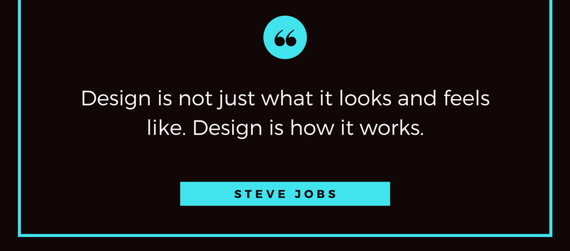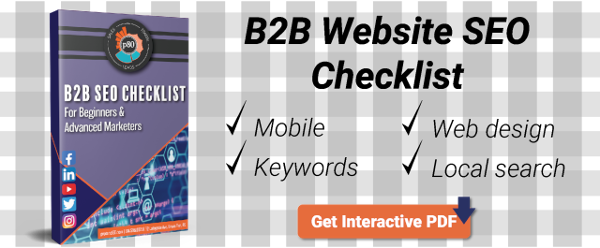Inbound Marketing Blog
for Manufacturers and Healthcare Companies
What Makes a Well Designed Industrial Website? [B2B Examples]
You'd think the determining factor of "good design" would be, y'know, the quality of the design. Right? Right?
Wrong. The true measure of a well-designed website is the response from your customers, not your peers or website design critics. The ultimate goal of your website is to attract customers and make sales, not look pretty. Right? Right.
"Usability and the utility, not the visual design, determine the success or failure of a web-site."
-- Vitaly Friedman
Let's see how you can make your industrial website design not just another pretty face, but also a fully functional lead machine:
What's the Best Industrial Website Design Look Like?
Oh, so you want to be more than average? Then your B2B website needs to not just look great, but also funnel each visitor to the right stepping stone on their buyer's journey.
To help your B2B website strategy, we'll provide examples for all five signs of great industrial website design:
- Everything is easy to find
- SEO necessities
- A suite of educational content
- "F" layout
- A clear purpose
- Communication that's simple & quick
1. Everything is easy to find.
User experience (UX) is the way a visitor is able to move through and interact with your website. The flow and accessibility of information, size and readability of text and graphic elements, and convenience of customer support all factor into B2B website UX.
Put more simply: Buttons, logins, and navigation menus should all be where you'd think they'd be.

John Deere's homepage is very easy to navigate. The links, images, CTAs, and info are all where you think they'd be. That makes it easy for visitors to immediately find what they're looking for, meaning they're less likely to bounce off the page.
If you're a manufacturer, especially a small one, your job is not to become a trailblazer on the website design scene. Give your customers what they expect to find. A "new and exciting" manufacturing website design, if you overdo it, can actually be stressful and confusing for potential customers.
That doesn't mean your website has to be boring -- it's very easy to apply modern, sleek, and professional elements to a simple and usable design. For example, here's Suburban Manufacturing's brand umbrella page:

Simple, attractive, and easy. The main navigation is still accessible at the top, and the search button is where you expect it to be in the top-right. Scrolling past the banner gives access to more info and clickables.
A little goes a long way when it comes to website design.
2. You have all the SEO necessities.
SEO (search engine optimization) is creating, promoting, and adjusting site content to improve its visibility in search engine results, thus attracting more traffic. Good SEO is another element of B2B website design that indicates your site easy to use and easy to find. If you don't have them, your website isn't performing effectively.
SEO work includes a variety of techniques, both visitor-facing and in the back end of your site. Specific to your site's layout and design, some of these include:
- Fast loading speed
- Inbound links
- 301 redirects
And there are plenty more to think about. All of these elements are necessary for Google AND your customers to properly absorb your site.
3. You have a suite of educational content.
The modern B2B buyer handles 70% of the decision-making process on their own before reaching out to a salesperson. It's not enough anymore for your site to simply consist of flashy videos and meaningless copy about how you're the greatest.
Amphenol Sensors, for example, devotes an entire main menu option to resources that make its potential buyers better-informed. Here's its vehicle sensor blog:

Areas you can improve your own site's helpfulness include:
- Message & branding: Like it or not, you're not the hero of your company's story. The customer is. Align your site's voice with your brand's core values; start by speaking directly to the pain points and aspirations of your B2B audience. This helps potential customers understand what your company stands for and that your product/service can solve their unique needs.
- Blogging & resources: Stock a resource library full of titles that grab the audience's attention (because they speak to those pain points!). Don't bury this hub several menu layers deep or in the footer. Create engaging content that includes clear next steps for the reader to take on your site (i.e. downloading an e-book).
- Customer proof: Yes, your website's ultimate goal is to sell, but why not let your happy customers handle that for you? Include testimonials and case studies (with real names and faces, if there are no NDAs) that show, rather than tell, that you really are that great. These can help potential buyers envision how your product/service would integrate with their project. Consider a variety of formats -- such as video testimonials, written case studies, and data metrics -- to cater to different audience preferences.
4. You've used 'F' layout to make eyeballs happy.
While aesthetics aren't the be-all end-all of design, you'll certainly drive customers away with a website that hit every branch as it fell from the ugly tree. When asked to describe why they mistrusted a website, 94% of comments were directly related to web design elements, while only 6% referenced specific content.
Your website should be average-looking at the very least, even if it won't win beauty pageants any time soon.
Many, many studies have been conducted on how we humans digest online information. We all seem to follow a particular "F"-shaped reading pattern.
What that means is we scan from left to right and then from top to bottom. Here's a heat graph representation from useit.com:
![]()
The red and yellow sections show where our eyes focus and linger.
Seems pretty simple, right? You'd be surprised (or not) how many websites fail to take this into account in their designs.
Your most important information should follow this "F" pattern. This will allow visitors to quickly determine whether your business is the right one for them, and then self-select in or out of your customer pool.
5. You – and every visitor – know your purpose.
How many times have you entered a company's homepage, scanned the whole thing, then said aloud, "So ... what exactly do these people do?"
Visitors should know what you offer within seconds. They should also clearly see what you want them to do on each page, i.e. sign up for a consultation. Take Mint.com for example, which makes it clear where it actually wants you to go:

You take a quick glance at this site and know a.) this service can help you manage your money, and b.) they want you to sign up for free.
Quick, simple, done. No time wasted.
6. Communicate quickly and simply.
Your visual design isn't the only thing that should be simple. Your homepage shouldn't have paragraphs upon paragraphs describing your business. Save that for your subpages.
All of the homepage examples we've shown (John Deere, Honda, Mint.com) have meaning conveyed in just a few short phrases.
That doesn't mean you should cut content just for simplicity's sake - actually, the more content you have, the more likely your visitors will convert.
Marketing guru Neil Patel did a quick experiment with the amount of text on his own homepage. He found that having 1,300 words on the page converted 7.6% better than 500 words.
That might seem like conflicting advice: don't have a lot of words on the page, but have a lot of words on the page? Huh?
What we're trying to say is use just a few phrases in your "F" layout section to convey meaning quickly. Then, fill in the gaps with high-quality, valuable content. Below all the gigantic, simple headlines on each of those websites is a fertile valley of great content.
Here's Suburban again, this time lower on the same page:

The image and copy clearly identify one of Suburban's product lines as well as the opportunity to apply for a job. Further down, there are an "About Us" video and contact information.
Your website's content shouldn't lack for quantity, but the most relevant information should be scannable. This allows your visitors to decide whether they're interested very quickly, and then delve into the meatier content if they choose.
Content should not be something you force on your visitors. It should be valuable, but optional.
Ultimately, the buyers who end up in your customer base have chosen to be there. Your content should simply give them all the information they need to make that choice.
Does Your Website Have What It Takes to Be Called 'Well-Designed?'
If not, try improving what you've already got before doing anything drastic. Take a little inspiration from the industrial website design legends above. Some B2B companies desperately need a full website overhaul, but others just need to simplify and relocate the good stuff they already have.
Whether you use HubSpot or WordPress, remember:
- KISS (keep it simple, stupid)
- "F" your website!
- What do you offer, and what should your visitors do?
- Communicate with simplicity up front, THEN give details
(Editor's note: This blog post was originally published in November 2015 and was recently updated with fresh examples.)
Our Blogs, Direct to Your Inbox!
How to Audit your Online Marketing
If you are executing digital marketing, congratulations! You are most likely already one step ahead of your competition, and making strides to meaningfully connect with prospects online. But, how do you know if you’re seeing continual success year over year, and improving your metrics?
Without the tools in place to analyze and benchmark your efforts, it is impossible to scale your online marketing and ensure continuous success.




